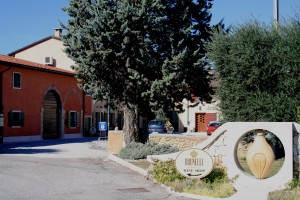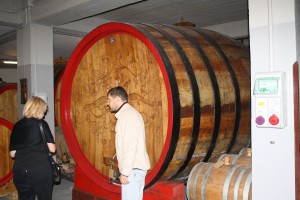General rules are meant to be broken. In general, the wines served at in-town tasting rooms are sub-par compared with those at wineries surrounded by lovely rows of vines. Fortunately, there are exceptions and there are good reasons to take a day to visit a town in Wine Country and find out what’s on offer there.
On a recent trip we decided to try our luck in the town of Napa, for several reasons. Our trip extended over a weekend and we wanted to avoid the crazy Sunday crowds and traffic on Route 29 and the Silverado Trail. Also, we had heard good things about the Oxbow Public Market and were looking forward to finding out what the buzz was all about. Finally, we wanted to eat lunch at the Bounty Hunter, of which we have written previously. [We never did dine there on this trip. It was ungodly hot and their air conditioning was on the fritz.]
The main drag for tasting rooms is 1st Street, running from the aforementioned Oxbow Public Market to the Napa civic center. As we had expected, there were some tasting rooms we did not enjoy very much. But there were also some that delightfully exceeded our expectations. The first of these was Capp Heritage. Even if you don’t like their wines – heck, even if you don’t like wine at all – their tasting room is worth seeing. It has two rooms, one of which is a lounge in which they have musical performances on the weekends. There are big easy chairs and a copper fireplace, which blessedly was unlit the day we were there. The other room contains brass chandeliers and a long mahogany bar that looks as though Diamond Jim Brady might walk up to it at any moment. That, of course, is where they pour the wine. (There’s a great wraparound picture of the bar on their web site, http://www.cappheritage.com). The Capps were primarily farmers who sold to winemakers until, like many growers in the region, they decided to bottle their own wines. We aren’t wine critics but we can say we enjoyed what we tasted, particularly an unusual Sangiovese and their Meritage.
Just down the street is John Anthony. That’s the label, the name of the tasting room and the first two names of the proprietor. We were surprised to learn that his last name is Truchard, son of Tony and JoAnn of Truchard Vineyards, which we have written about in a previous article. The tasting room is nouveau chic, looking more like a night spot than a place for serious wine tasting. In fact, that’s the way they advertise, appealing to those out on the town in Napa for an evening. On a lazy Sunday afternoon, we were the only visitors and the server was able to give us his full attention and quite an introduction to the wines, which were very serious indeed. There’s a top-end Cabernet, not usually available for tasting, that really impressed us. They have a special deal they call the List: sign up for as few as six bottles a year and they lock in the price forever. We don’t understand he business model but it sounds like quite a deal.
Unfortunately, there were others that we didn’t enjoy nearly as much. You may have heard of Cosentino Winery in Yountville. Mitch Cosentino sold it a few years ago and opened pureCru, which can best be called a boutique winery with a hip looking tasting room just off 1st Street. Our server will be a twentysomething in a few years. She knew very little about what she was pouring and so we just had to drink our wine and make our own determinations. Fair enough, but we weren’t that enthralled with what we were drinking.
The worst of the lot was a dreary room two blocks off 1st Street at Clinton Street. There they serve Havens and Stonehedge wines. The server seemed bored, unwilling or unable to answer questions and gave off an attitude that we were spoiling her Sunday afternoon solitude. We didn’t care for the wine much but that wasn’t the point. If they had been presented to us in a friendly, welcoming manner it would have made for a better tasting experience and we might have liked the wines more.
There are other tasting rooms and bars with extensive by-the-glass lists in Napa Town. The Oxbow Public Market is made for urban foodies out in the country for the day, which just about describes us. It’s a fun place and you might want to have lunch or a snack at one of the many eateries there. All in all, we spent a very pleasant day of our trip in the town of Napa. We’ll be back.
 The Brunelli Winery
The Brunelli Winery Francesco Grigoli showing Lucie the cask
Francesco Grigoli showing Lucie the cask